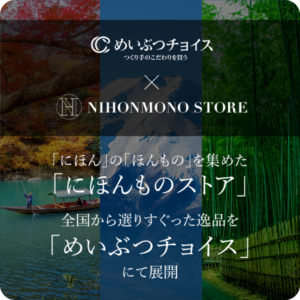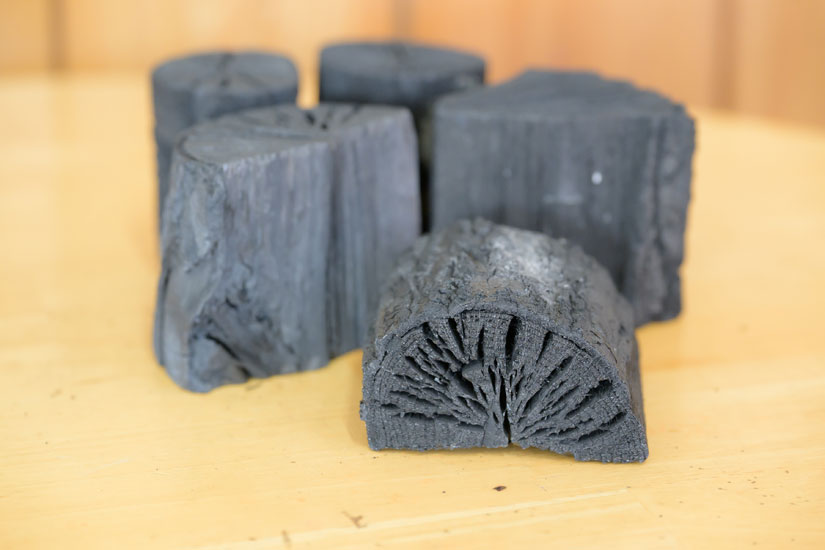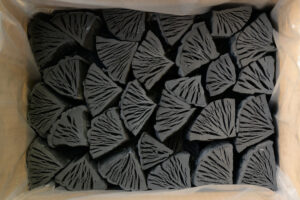Iwate Prefecture boasts Japan’s largest charcoal production. In Iwate Prefecture, about a quarter of the charcoal produced is from the town of Hirono in the northern part of the prefecture. One of the charcoal makers in Hoku Sangyo, a longtime charcoal producer in the town of Hirono, is Sachiko Ichijo, a charcoal maker who has won awards at the Iwate Prefecture Charcoal Fair.
Charcoal Production in Hirono Town Developed in Connection with Steel Manufacturing
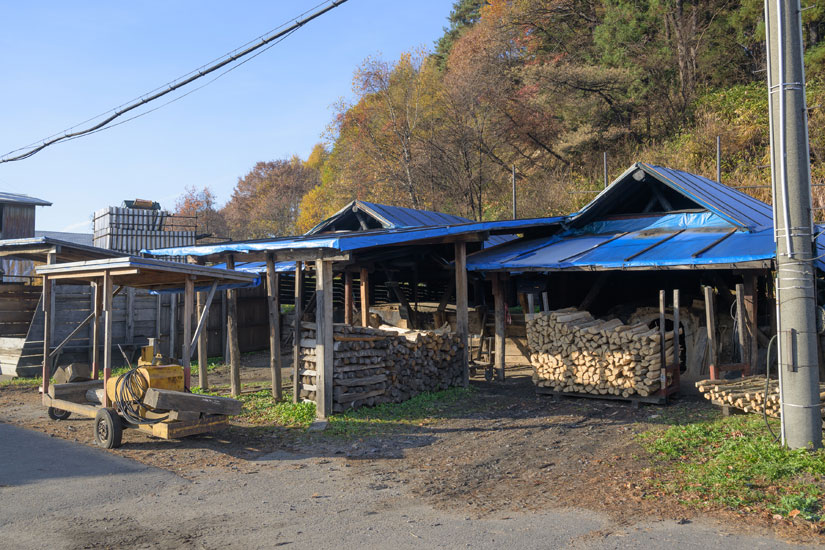
One of the reasons why charcoal production is thriving in Hirono Town is the abundance of native hardwood trees, the material used to make charcoal. Moreover, the mountains where the hardwood trees grow are gentle, making it easy to cut and transport the charcoal.
Another reason is the connection with iron manufacturing. The Ono area of Hirono Town prospered during the feudal era because of its iron manufacturing industry, known as “tatara-zeki” (tatara iron manufacturing). Tatara-tekketsu is a traditional Japanese iron manufacturing method in which iron sand and charcoal are placed in a clay furnace and burned while air is blown through the furnace to produce iron. Charcoal was indispensable to iron manufacturing because iron sand was transformed into iron oxide by combustion, which was then reduced to iron by combining with carbon, a component of charcoal.
In the Meiji period (1868-1912), Western-style blast furnaces began to be used to make iron, and tatara iron manufacturing declined, but charcoal production continued in the Ono area as the demand for charcoal as a household fuel increased. In addition, many farmers in other areas of Iwate Prefecture also made charcoal during the off-season, and the opening of the Tohoku Line made it easier to ship charcoal to the Tokyo market, and the prefecture encouraged charcoal production. In 1912, the prefecture became Japan’s largest charcoal producer.
The raw material is oak trees 20 to 30 years old.
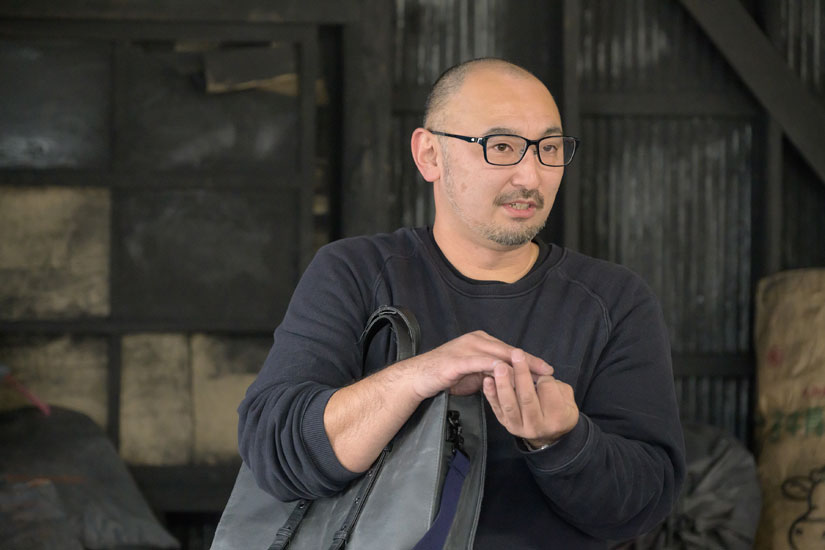
Charcoal is carbonized by heating wood in the absence of oxygen to remove oxygen, hydrogen, and impurities, leaving only carbon. White charcoal is represented by binchotan, which is made mainly from ubame oak trees. On the other hand, black charcoal is made in Iwate, and the wood used to make it is oak, which grows abundantly in the prefecture. The trees are 20 to 30 years old, and one of the reasons for this is that “when calculating backwards from the thickness of the finished charcoal, a tree with a diameter of 20 cm is suitable,” he says.
Since many of our customers are restaurants, such as Robata-yaki restaurants and Yakitori restaurants, they require charcoal to have a long-lasting flame. Hard and dense oak holds fire well when made into charcoal, which is another reason why we use oak as a raw material,” explains Akira Sasaki, president of Hoku Sangyo, located in Yono-cho. The company was formerly known as “Sasaki Lumber Store” founded in 1952, and started its charcoal-making business a few years later. Currently, the company has 16 kilns producing “Iwate Charcoal,” which is a registered product under the Geographical Indication (GI) protection system, as well as charcoal, powdered charcoal, wood vinegar solution, and other products.
Good Charcoal” Means “Good Fire Life
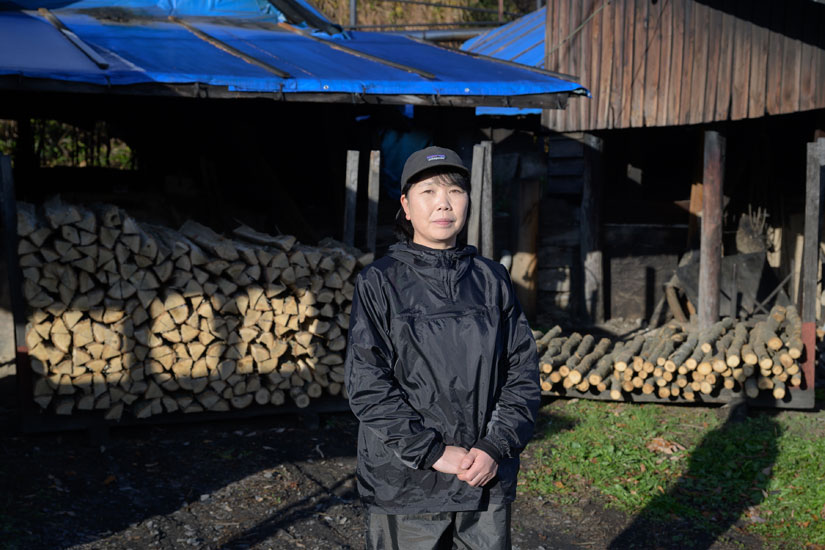
Sachiko Ichijo began making charcoal three years ago. Until then, she had been in charge of cutting and packing finished charcoal into bags and boxes, but she became interested in the charcoal-making process and decided that she wanted to try it herself, rather than just watching and listening to the process.
He learned charcoal making from a senior craftsman. First, he cut the oak logs to the standard length and thickness, stood them inside the kiln, lit the fire at the entrance, and let them dry for four days. The entrance to the kiln is then closed, and the amount of oxygen in the kiln is adjusted by moving the ventilation openings and smoke openings to carbonize the wood. Once completely carbonized, the kiln is closed at all entrances to shut off the oxygen and allowed to cool for about a week before the kiln is complete. The time from ignition to digestion varies depending on the dryness of the logs and the climate, but it takes about two to three weeks. In other words, it takes three to four weeks to complete the process.
Aiming for “hard,” “heavy,” and “low-pasteurization” charcoal
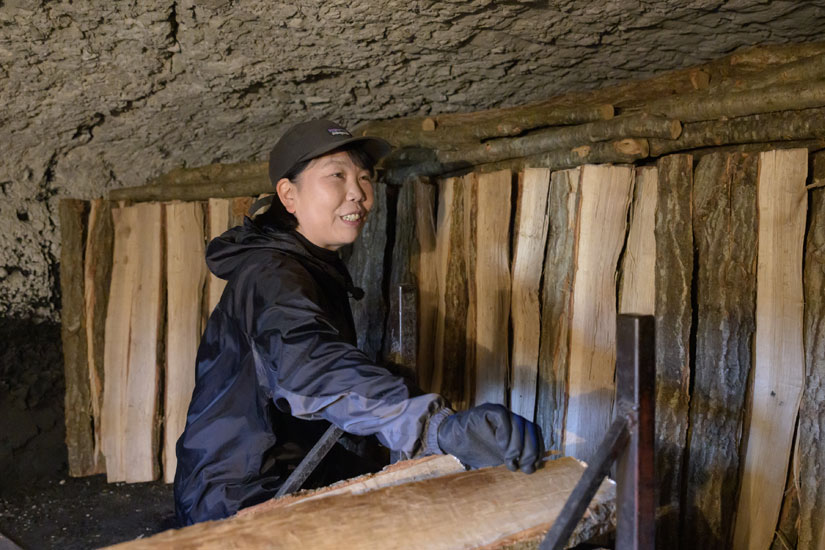
The most difficult part is to line up the logs in a straight line with no gaps between them in order to keep the inside of the kiln in an acidic state,” says Mr. Kikuchi. But the most important part is to block the entrance to the kiln and move the ventilation openings and smoke openings while carbonizing the charcoal,” says Ichijo. This is where the quality of the charcoal is determined. For Ichijo, good charcoal is “hard and heavy,” or “dense,” which is also a requirement for “charcoal that burns well. If the burning (carbonization) speed is too fast, it will result in low-density, scraggly charcoal, so he adjusts the carbonization speed by measuring the temperature at the smoke opening.
He says, “Before the charcoal is digested, the smoke outlet is opened wide to raise the temperature inside the kiln and increase the carbonization rate. The lower the value, the lower the impurities and the higher the carbon purity (carbonization), in other words, the higher the quality of charcoal. Iwate Charcoal, which has been approved for registration under the Geographical Indication (GI) protection system, is defined as having a purity of 8% or less, and this value is used as the standard for the fair. The bottom part of the finished charcoal is highly refined, so in the case of “Iwate Charcoal” it is cut off before shipping, but Hokubu Sangyo does not cut off the bottom part but inspects it according to its own standards and ships it as “Nara Charcoal.
Senior charcoal makers say that you can tell the state of carbonization and the timing of refining by the smoke and smell, but I have not reached that level yet, so I don’t know. So now I start refining when the temperature at the smoke outlet reaches 320°C. But I hope to be able to tell someday. But someday I would like to be able to understand it. That’s why every day is a learning experience, and that’s why every day is interesting,” Ichijo says with a smile.
Appearance is also an object of evaluation at the fair.
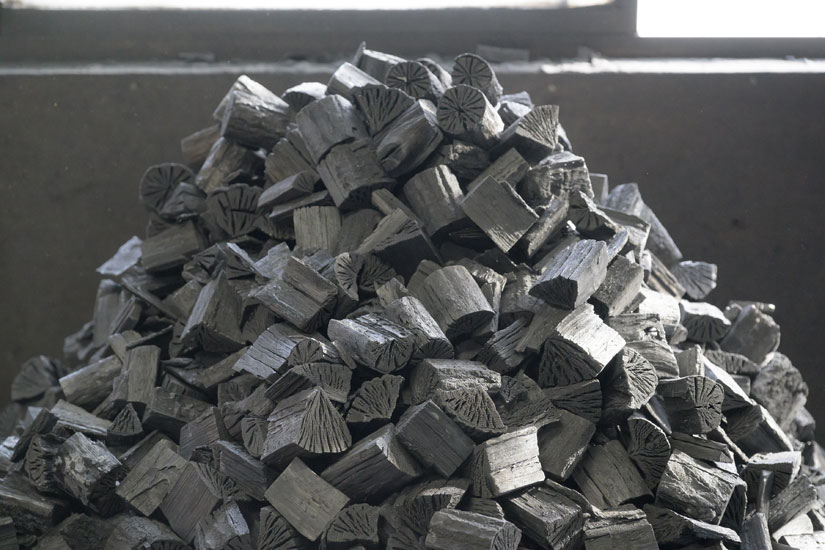
In the course of repeated charcoal making, Ichijo finds charcoal that he thinks is “well done,” and saves it to exhibit at a charcoal show. In addition to the aforementioned “hardness, heaviness,” and “degree of refinement,” Ichijo also considers “appearance” to be a requirement for “good charcoal,” so he selects charcoal with clean bark. As a result, at the 2022 Iwate Charcoal Fair, the company received the Minister of Agriculture, Forestry and Fisheries Award in the black charcoal cut charcoal category and the Director-General of the Forestry Agency Award in the black charcoal long charcoal category. The cut charcoal was approximately 6.5 cm long and the long charcoal was approximately 30 cm long.
I don’t want to end the charcoal-making technique and culture.
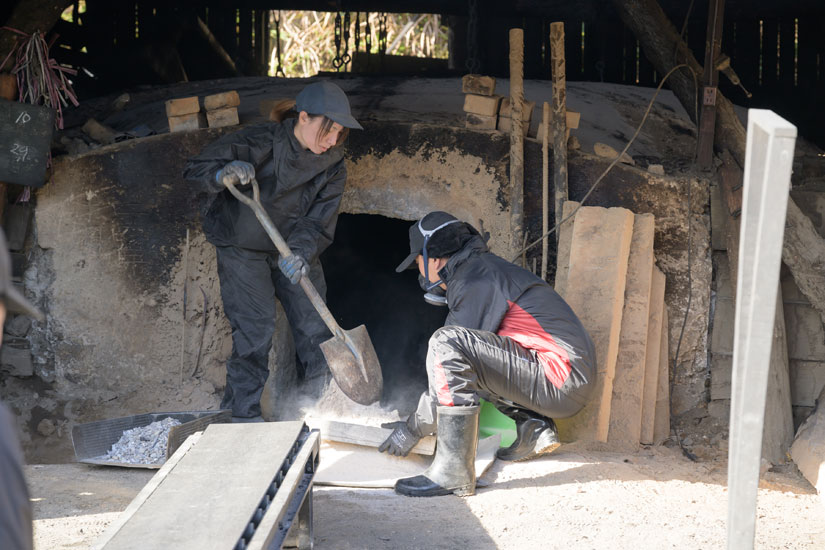
According to Mr. Sasaki, there is so much demand for charcoal in Japan right now that the company’s production cannot keep up. The company has been receiving an increasing number of orders for charcoal for use in camping at Corona Disaster and later for use in restaurants such as yakitori (grilled chicken) restaurants.
Even under such circumstances, we always try to produce charcoal of consistent quality. Also, we want to respond to any order. For example, some customers want charcoal that is softer and easier to crush than our Iwate Charcoal or Nara Charcoal, so we sometimes have to search inside the kiln to deliver it to them,” Sasaki says proudly.
Mr. Ichijo, on the other hand, says, “When you make charcoal, you also get ash for incense burners and braziers, and ‘wood vinegar,’ which is made by cooling the smoke, so there is no waste. I don’t want to let this charcoal-making technique and culture die out, so I want to continue making charcoal for 10 years, or even 20 years,” he says. Mr. Ichijo concentrates on each and every task, day in and day out, with only one thing in mind: making “good charcoal. Ichijo’s attitude will surely lead to the emergence of the next generation of young people who aspire to become charcoal makers.
